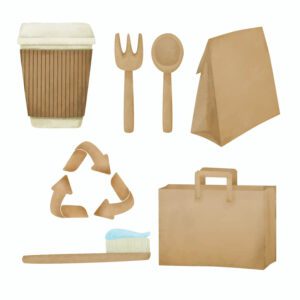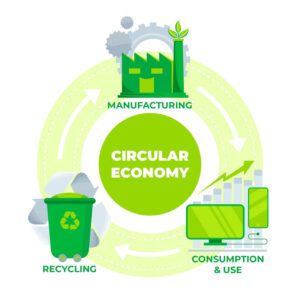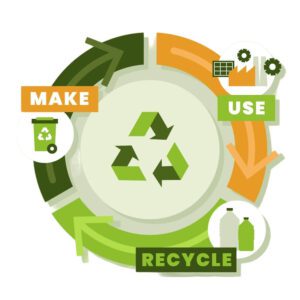Reducing our carbon footprint and promoting sustainability has become more crucial than ever before. Every individual has a role to play in ensuring that we protect our planet for future generations.
One way to do this is by using recycled materials in our daily lives.
10 Ways to Reduce Your Carbon Footprint with Recycled Materials
In this article, we will know the top 10 ways to reduce your carbon footprint with recycled materials. Which is beneficial for our environment.
1) Use recycled paper products
Paper production contributes to deforestation, which causes a significant increase in atmospheric carbon dioxide levels. By using recycled paper products, you are reducing the demand for virgin wood pulp, and thus reducing the carbon footprint of paper production.

According to the United States Environmental Protection Agency, recycling one ton of paper can save 17 trees and 7,000 gallons of water.
2) Use recycled plastic products
Plastics are one of the most significant contributors to environmental pollution. By using recycled plastic products, you are reducing the amount of plastic waste that ends up in landfills or oceans.

According to the European Commission, recycling plastic can save up to 80% of the energy used in virgin plastic production.
3) Purchase recycled clothing
The fashion industry is a significant contributor to carbon emissions. Purchasing recycled clothing reduces the demand for new clothing production and the carbon footprint associated with it.

According to a study by the UK-based Waste & Resources Action Programme (WRAP), extending the life of clothing by nine months can reduce carbon, water, and waste footprints by around 20-30% each.
4) Use recycled glass products
Glass production requires a considerable amount of energy and releases carbon dioxide into the atmosphere. By using recycled glass products, you are reducing the demand for new glass production and the associated carbon footprint.

According to the Glass Packaging Institute, recycling glass saves 74% of the energy required to produce new glass.
5) Purchase recycled building materials
Building and construction materials contribute to a significant amount of carbon emissions. Purchasing recycled building materials reduces the demand for new materials and the associated carbon footprint.

According to a study by the European Commission, recycling construction and demolition waste can save up to 90% of the energy used in virgin material production.
6) Use recycled batteries
Batteries contain toxic chemicals that can harm the environment if not disposed of correctly. By using recycled batteries, you are reducing the demand for new battery production and the associated carbon footprint.

According to a study by the European Commission, recycling batteries can save up to 70% of the energy used in virgin battery production.
7) Purchase recycled furniture
Furniture production requires a considerable amount of energy and resources. Purchasing recycled furniture reduces the demand for new furniture production and the associated carbon footprint.

According to a study by the UK-based Furniture Industry Research Association (FIRA), recycling furniture can reduce carbon emissions by up to 95% compared to virgin material production.
The Benefits of Buying Second-Hand Furniture
8) Use recycled metal products
Metal production, particularly steel production, is one of the most energy-intensive industries globally. By using recycled metal products, you are reducing the demand for new metal production and the associated carbon footprint.

According to the Steel Recycling Institute, recycling steel saves 60% of the energy required to produce new steel.
9) Purchase recycled electronics
Electronic waste is a significant contributor to environmental pollution. Purchasing recycled electronics reduces the demand for new electronics production and the associated carbon footprint.

According to a study by the European Commission, recycling electronic waste can save up to 85% of the energy used in virgin electronic production.
10) Use recycled packaging materials
Packaging materials contribute to a significant amount of waste and pollution. Using recycled packaging materials reduces the demand for new packaging production and the associated carbon footprint.

According to the European Commission, recycling packaging waste can save up to 95% of the energy used in virgin packaging production.
Data for some countries:
- In the United States, recycling one ton of paper saves enough energy to power the average American home for six months.
- In the European Union, 25 million tons of plastic waste are generated annually, and only 30% of it is recycled.
- In the United Kingdom, the textile industry is responsible for 4% of the UK’s total carbon emissions and 10% of its water footprint.

- In France, the construction and demolition sector generates around 46 million tons of waste every year, of which only 40% is recycled.
- In Germany, around 1.5 million tons of electronic waste are generated annually, but only about one-third of that is recycled.
Conclusion:
In conclusion, reducing your carbon footprint through the use of recycled materials is a simple yet effective way to promote sustainability.

By incorporating these ten practices into your daily life, you can make a significant impact on the planet. Let’s work together to create a sustainable future for ourselves and future generations.
Other Posts To Read:
How to Turn Scrap Metal into Art: Tips and Tricks
The value of second-hand furniture and how to find high-quality pieces
How to identify and avoid common scams when buying second-hand furniture online.
The benefits of donating unwanted items to charity or non-profit organizations
